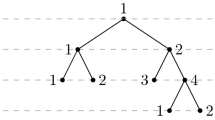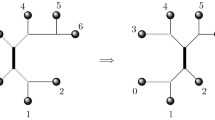Abstract
This paper describes a growth model for binary topological trees. The model defines the branching probability of all segments in the tree. The branching probability of a segment is formulated as a function of two variables, one indicating its type (intermediate or terminal), the other representing its order, i.e. the topological distance to the root segment. The function is determined by two parameters, namely the ratio of branching probabilities of intermediate and terminal segments and the strength of the order dependency, implemented in an exponential form. Expressions are derived for the calculation of symmetry properties of the partitions and it is indicated which part of the parameter domain results in predominantly symmetrical trees.
Similar content being viewed by others
Literature
Berry, M., T. Hollingworth, E. M. Anderson and R. M. Flinn. 1975. “Application of Network Analysis to the Study of the Branching Patterns of Dendritic Fields.” InAdvances in Neurology, G. W. Kreutzberg (Ed.), Vol. 12, pp. 217–245. Raven, New York.
Dacey, M. F. and W. C. Krumbein. 1976. “Three Growth Models for Stream Channel Networks.”J. Geol. 84, 153–163.
Harding, E. F. 1971. “The Probabilities of Rooted Tree-shapes Generated by Random Bifurcation.”J. appl. Prob. 3, 44–77.
Hollingworth, T. and M. Berry. 1975. “Network Analysis of Dendritic Fields of Pyramidal cells in Neocortex and Purkinje Cells in the Cerebellum of the Rat.”Phil. Trans. R. Soc. B270, 227–264.
MacDonald, N. (1984). “The Usefulness of Growth Models for Trees.”J. theor. Biol. 111, 419–423.
Van Pelt, J. and R. W. H. Verwer. 1983. “The Exact Probabilities of Branching Patterns Under Terminal and Segmental Growth Hypotheses.”Bull. math. Biol. 45, 269–285.
— and —. 1985. “Growth Models (Including Terminal and Segmental Branching) for Topological Binary Trees.”Bull. math. Biol. 47, 323–336.
Verwer, R. W. H. and J. van Pelt. 1983. “A New Method for the Topological Analysis of Neuronal Tree Structures.”J. Neurosci. Meth. 8, 335–351.
Van Pelt, J., R. W. H. Verwer and A. J. Noest. “Estimation of Parameters in Topological Growth Models for Neuronal Trees.”Bull. math. Biol. (submitted).
Author information
Authors and Affiliations
Rights and permissions
About this article
Cite this article
Van Pelt, J., Verwer, R.W.H. Topological properties of binary trees grown with order-dependent branching probabilities. Bltn Mathcal Biology 48, 197–211 (1986). https://doi.org/10.1007/BF02460023
Received:
Issue Date:
DOI: https://doi.org/10.1007/BF02460023




